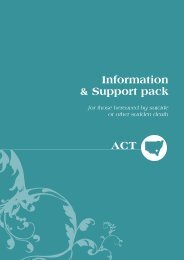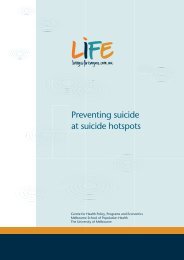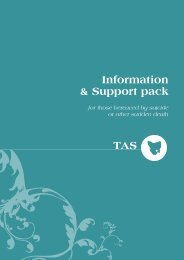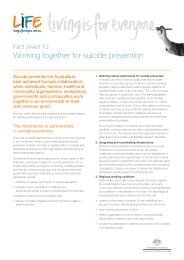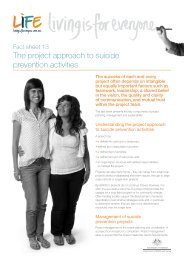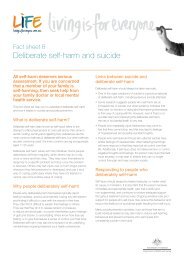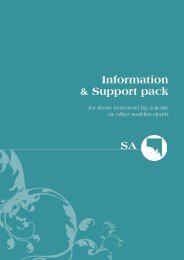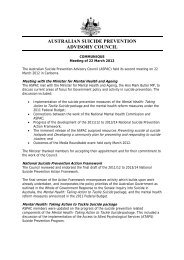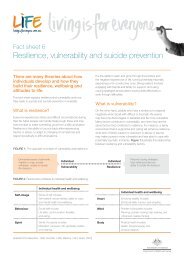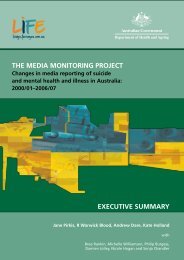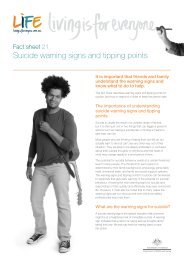SUICIDE in RURAL & REMOTE AREAS of AUSTRALIA - Living is for ...
SUICIDE in RURAL & REMOTE AREAS of AUSTRALIA - Living is for ...
SUICIDE in RURAL & REMOTE AREAS of AUSTRALIA - Living is for ...
You also want an ePaper? Increase the reach of your titles
YUMPU automatically turns print PDFs into web optimized ePapers that Google loves.
Suicide <strong>in</strong> rural and remote areas <strong>of</strong> Australia 81<br />
D<strong>is</strong>cussion<br />
In th<strong>is</strong> chapter, we conducted a literature review<br />
<strong>of</strong> the suicide prevention <strong>in</strong>itiatives <strong>for</strong> rural<br />
communities <strong>in</strong> Australia. Th<strong>is</strong> <strong>in</strong>cluded a search <strong>of</strong><br />
appropriate databases <strong>for</strong> any relevant publications,<br />
as well as a search <strong>of</strong> relevant web-sites <strong>for</strong> suicide<br />
prevention programs and services implemented <strong>in</strong><br />
rural areas. The ma<strong>in</strong> aim <strong>of</strong> the literature review was<br />
to identify ex<strong>is</strong>t<strong>in</strong>g suicide prevention <strong>in</strong>itiatives (i.e.,<br />
programs, services, and <strong>in</strong>itiatives). The identifi ed<br />
<strong>in</strong>itiatives were classifi ed <strong>in</strong>to three groups:<br />
1. Suicide prevention <strong>in</strong>itiatives <strong>for</strong> rural population<br />
<strong>in</strong> general<br />
2. Suicide prevention <strong>in</strong>itiatives <strong>for</strong> farmers<br />
3. Suicide prevention <strong>in</strong>itiatives <strong>for</strong> Indigenous<br />
population<br />
For all <strong>of</strong> these groups – the rural population as a<br />
whole and the two sub-populations (farmers and<br />
Indigenous population) – recommendations were<br />
provided and d<strong>is</strong>cussed.<br />
Overall, we found that:<br />
• More activities are based <strong>in</strong> the prov<strong>is</strong>ion <strong>of</strong><br />
recommendations than active <strong>in</strong>terventions <strong>for</strong><br />
suicide prevention <strong>for</strong> rural populations;<br />
• The majority <strong>of</strong> programs address the <strong>is</strong>sue<br />
<strong>of</strong> suicide prevention <strong>in</strong>directly (e.g. via<br />
strengthen<strong>in</strong>g community networks);<br />
• Indirect suicide prevention approaches <strong>in</strong><br />
rural areas <strong>of</strong>ten address variables on a<br />
collective level, such as community attitudes<br />
towards help-seek<strong>in</strong>g or farmers’ attitudes<br />
towards health;<br />
• There are very few programs where an<br />
evaluation <strong>of</strong> outcomes <strong>is</strong> available. Further,<br />
most evaluations were not conducted <strong>in</strong><br />
parallel with a ‘control group’, which makes<br />
it diffi cult to account <strong>for</strong> other possible<br />
environmental or <strong>in</strong>dividual factors that brought<br />
about the noted changes.<br />
• Due to these factors, it was diffi cult to assess<br />
whether <strong>in</strong>terventions <strong>in</strong> rural areas actually<br />
made a difference <strong>in</strong> terms <strong>of</strong> a reduction<br />
<strong>in</strong> suicide.<br />
Aside from th<strong>is</strong>, another important consideration<br />
<strong>for</strong> the future <strong>of</strong> any suicide prevention program<br />
<strong>is</strong> whether it can be naturally susta<strong>in</strong>ed with<strong>in</strong><br />
a community after project completion. Th<strong>is</strong> <strong>is</strong><br />
especially vital <strong>in</strong> rural areas given their already<br />
scarce resources. Indeed, susta<strong>in</strong>ability can be<br />
considered an <strong>in</strong>direct measure <strong>of</strong> a program’s<br />
effectiveness; the more positive community changes<br />
follow<strong>in</strong>g the implementation <strong>of</strong> a program, the more<br />
likely these changes will enhance resilience to and<br />
reduce the r<strong>is</strong>k <strong>of</strong> self-harm and suicidal behaviours<br />
<strong>in</strong> that community. However, it must be noted that<br />
susta<strong>in</strong>ability and effectiveness are not necessarily<br />
positively-related concepts. Th<strong>is</strong> means that ongo<strong>in</strong>g<br />
evaluation should rema<strong>in</strong> a vital component <strong>of</strong> any<br />
effective suicide prevention program <strong>in</strong> Australia<br />
(LIFE, 2007). Additionally, it <strong>is</strong> equally important<br />
to monitor any negative or harmful effects that may<br />
occur as determ<strong>in</strong><strong>in</strong>g suicide prevention approaches<br />
that may reduce suicide rates.<br />
• Only few programs report about any results <strong>of</strong><br />
their activities; and,<br />
GriffithBook FINAL 20/09.<strong>in</strong>dd 81<br />
15/11/12 4:28 PM



